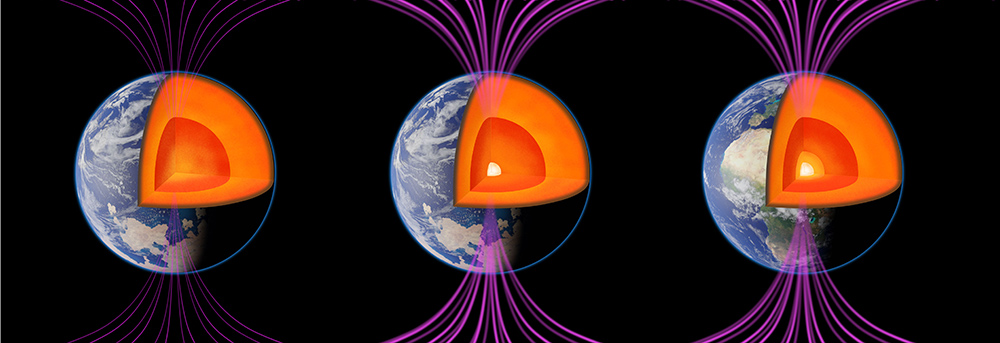What saved Earth from the fate of Mars?
Three billion years ago, liquid water existed on Mars as well as on Earth. Today, this is only the case on our home planet. Why is that? Mars no longer has such a strong magnetic field as the Earth. Therefore the solar wind can take the atmosphere better there than here. The magnetic field is generated in the outer core of the Earth, where liquid iron rotates (this is called a “geodynamo”). About 565 million years ago, however, the strength of the magnetic field decreased to 10 percent of its present strength. Then the field mysteriously recovered and regained strength just before the Cambrian explosion of multicellular life on Earth.
According to new research by scientists at the University of Rochester, this rejuvenation occurred within tens of millions of years – rapid in geologic timescales – and coincided with the formation of Earth’s solid inner core. “The inner core is hugely important,” says John Tarduno of the University of Rochester. “Just before the inner core began to grow, the magnetic field was on the verge of collapse. But as soon as the inner core grew, the field regenerated. In their work, published in Nature Communications, the researchers determined several key dates in the inner core’s history, including a more accurate estimate of its age. The research provides insight into the history and future evolution of Earth and how it became a habitable planet, as well as the evolution of other planets in the solar system.
Because of the relationship between the magnetic field and Earth’s core, scientists have been trying for decades to figure out how the magnetic field and Earth’s core have changed throughout the history of our planet. Because of its location and extreme temperatures, they cannot measure the magnetic field directly. Fortunately, minerals that rise to Earth’s surface contain tiny magnetic particles that capture the direction and intensity of the magnetic field at the time the minerals cool from their molten state. To better constrain the age and growth of the inner core, Tarduno and his team examined feldspar crystals from the rock anorthosite using a CO2 laser and a magnetometer. This allowed the researchers to determine two important new dates in the history of the inner core:
550 million years ago, for example, the magnetic field began to rapidly renew itself after its near-collapse 15 million years earlier. The researchers attribute the rapid renewal of the magnetic field to the formation of a solid inner core that recharged the molten outer core and restored the strength of the magnetic field.
The structure of the inner core changed 450 million years ago, forming a boundary between the inner core and the outer inner core. “As we were able to constrain the age of the inner core more precisely, we found that today’s inner core is actually made up of two parts,” Tarduno says. “Plate tectonic movements at the Earth’s surface have indirectly affected the inner core, and the history of these movements is imprinted deep within the Earth’s interior in the structure of the inner core.”
A better understanding of the dynamics and growth of the inner core and magnetic field has important implications, not only for studying Earth’s past and predicting its future, but also for how other planets might form magnetic shields and maintain the conditions necessary for life to emerge.
What would have happened if the magnetic field had not recovered so quickly back then? “Earth would have lost a lot more water, for sure,” Tarduno says. “Our planet would be much drier today and very different than we know it.”
